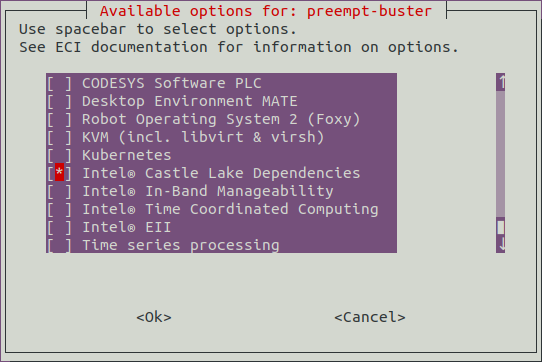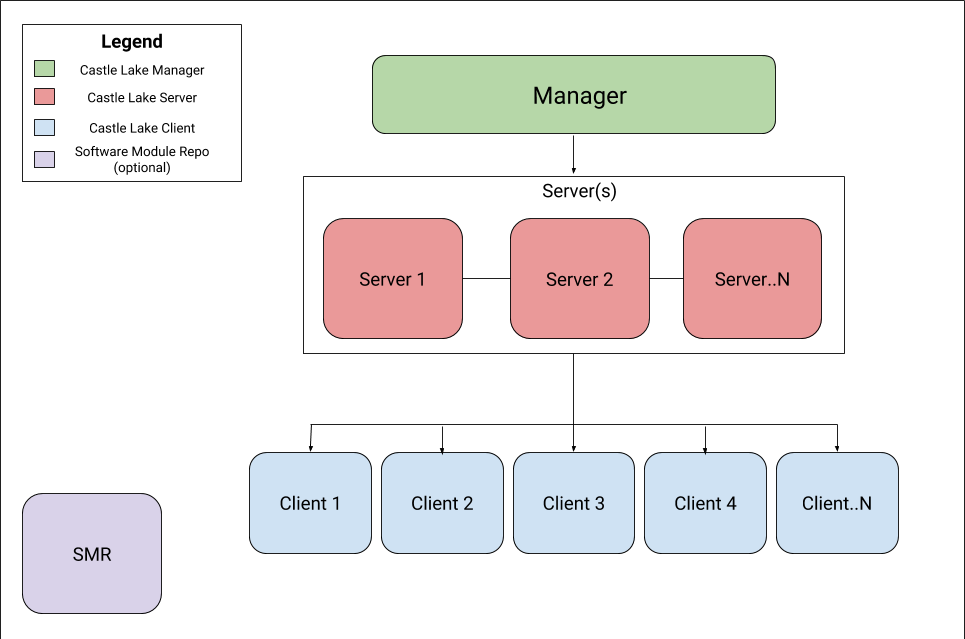Application Management - Intel® Castle Lake¶
Important
Intel® Castle Lake dependencies must be enabled in the ECI image before Intel® Castle Lake can be used. Creating an ECI image that contains the Intel® Castle Lake dependencies can be accomplished by selecting the Intel® Castle Lake Dependencies feature option during image setup. See section Building ECI for more information.

Castle Lake Overview¶
Castle Lake (CSL) enables applications to be deployed and executed into a distributed architecture. The process of matching, instantiating, and deploying logical software modules into a physical environment is called orchestration. Once deployed, these modules must be able to work together to meet application goals.

Castle Lake consists of the following components:
Castle Lake Manager
CSL Manager provides a REST API for cluster management, application lifecycle management, and registering software modules for use in applications. CSL Manager also provides a reference web-based graphical user interface (GUI) for the CSL system. Deployment of jobs is performed through this GUI. Through the web application, we can view the various nodes, their constraints, deployed jobs (if any).
Castle Lake Server Node
A CSL server node can either be set up on any virtual machine (VM) or physical server. This node contains the components needed to communicate with CSL manager and CSL client node to enable the core workload orchestration. Note: server and CSL manager could be hosted on the same node. CSL Client cannot be installed on a node with a CSL Server
Castle Lake Client Node
A CSL client node can either be set up on any virtual machine (VM) or physical server. This node contains the components needed to communicate with the server node to receive and execute workloads. Note: A CSL Client cannot be installed on a node with a CSL Server.
Software Module Repository
The SMR is an optional server where deployable modules are stored. It can be setup on any physical server or VM.
Deploying Intel® Castle Lake¶
Please refer to the Castle Lake documentation Documentation-release#.#.#.tar.gz located at Support/CSL within the ECI release archive (release-eci_#.#.zip) for more information on installing, configuring, and deploying Castle Lake. Prepare the Castle Lake release package by performing the steps below:
The following section is applicable to:

Copy the CSL release archives
ReleasePackage-release#.#.#tar.gzandDocumentation-release#.#.#.tar.gzfrom the ECI release archive (release-eci_#.#.zip) to the Linux build system. The CSL release content is located in the ECI release archive within theSupport/CSLdirectory as follows:└── Support └── CSL ├── Documentation-release#.#.#.tar.gz ├── Pre-Production-release#.#.#.tar.gz ├── ReleasePackage-release#.#.#tar.gz └── Src-Collaterals-release#.#.#.tar.gz
Open a terminal on the Linux build system and change to the directory containing the CSL release archives.
From the terminal, extract the CSL release archive by performing the following command:
$ tar -xzvf ./ReleasePackage-release#.#.#tar.gz $ tar -xzvf ./Documentation-release#.#.#.tar.gz
The archives should extract, revealing a directories named
ReleasePackageandDocumentation.Navigate to the extracted
ReleasePackagedirectory. The contents of the directory should be similar to:$ ls CodeSys deployment Docs License
Navigate to the extracted
Documentationdirectory. The contents of the directory should be similar to:$ ls html Start_Documentation.html
Explore the Castle Lake documentation for more information. Open the
Start_Documentation.htmlpage in a web browser to get started.
Deploy Intel® Castle Lake Client on ECI¶
Please refer to the Castle Lake release package bundled with ECI for more information on installing, configuring, and deploying Castle Lake. Deploy a Castle Lake Client on ECI by performing the steps below:
The following section is applicable to:

Build an ECI image with Intel® Castle Lake dependencies enabled. Creating an ECI image that contains Intel® Castle Lake dependencies can be accomplished by selecting the
Intel® Castle Lake Dependenciesfeature option during image setup. See section Building ECI for more information.
Attention
For Debian Builds Only - Do not enable the following feature options if the CSL Client will be deployed using Kubespray. These feature options install components which are not compatible with Kubespray.
KVM (incl. libvirt & virsh)KubernetesIntel® In-Band Manageability
Note
For Debian Builds Only - If it is known that Antrea will be used and it is less than version 0.13.0, then it is recommended to enable the
Antrea < v0.13.0 kmod hackfeature option during image setup. This option modifies the kmod package to work with Antrea.After building an ECI image with the
Intel® Castle Lake Dependenciesfeature option enabled, install the ECI image to a target system by following section: Installing ECI-B/R/X.Follow the Castle Lake documentation for more information on deploying a CSL Client. A good starting point is
user.htmlor theUser Manualsection.